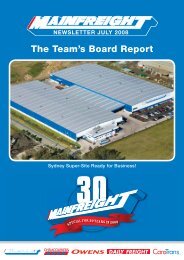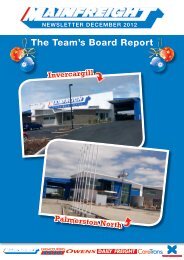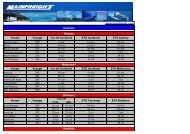Annual Report 2013 - Mainfreight
Annual Report 2013 - Mainfreight
Annual Report 2013 - Mainfreight
You also want an ePaper? Increase the reach of your titles
YUMPU automatically turns print PDFs into web optimized ePapers that Google loves.
2 Summary of Significant Accounting Policies (continued)<br />
(t) Income Tax and Other Taxes (continued)<br />
Deferred income tax assets are recognised for all deductible temporary differences, carry-forward of unused tax credits and unused tax<br />
losses, to the extent that it is probable that taxable profit will be available against which the deductible temporary differences and the<br />
carry-forward of unused tax credits and unused tax losses can be utilised, except:<br />
• When the deferred income tax asset relating to the deductible temporary difference arises from the initial recognition of an asset<br />
or liability in a transaction that is not a business combination and, at the time of the transaction, affects neither the accounting<br />
profit nor taxable profit or loss; or<br />
• When the deductible temporary difference is associated with investments in subsidiaries, associates or interests in joint ventures,<br />
in which case a deferred tax asset is only recognised to the extent that it is probable that the temporary difference will reverse in<br />
the foreseeable future and taxable profit will be available against which the temporary difference can be utilised.<br />
The carrying amount of deferred income tax assets is reviewed at each balance sheet date and reduced to the extent that it is no longer<br />
probable that sufficient taxable profit will be available to allow all or part of the deferred income tax asset to be utilised.<br />
Unrecognised deferred income tax assets are reassessed at each balance sheet date and are recognised to the extent that it has<br />
become probable that future taxable profit will allow the deferred tax asset to be recovered.<br />
Deferred income tax assets and liabilities are measured at the tax rates that are expected to apply to the year when the asset is realised<br />
or the liability is settled, based on tax rates (and tax laws) that have been enacted or substantively enacted at the balance sheet date.<br />
Income taxes relating to items recognised directly in equity are recognised in equity and not in profit or loss.<br />
Deferred tax assets and deferred tax liabilities are offset only if a legally enforceable right exists to set off current tax assets against<br />
current tax liabilities and the deferred tax assets and liabilities relate to the same taxable entity and the same taxation authority.<br />
Other Taxes<br />
Revenues, expenses, liabilities and assets are recognised net of the amount of GST, except:<br />
• When the GST incurred on a purchase of goods and services is not recoverable from the taxation authority, in which case the<br />
GST is recognised as part of the cost of acquisition of the asset or as part of the expense item as applicable; and<br />
• Receivables and payables, which are stated with the amount of GST included.<br />
The net amount of GST recoverable from, or payable to, the taxation authority is included as part of receivables or payables in the<br />
balance sheet.<br />
Cash flows are included in the Cash Flow Statement on a net basis and the GST component of cash flows arising from investing and<br />
financing activities, which is recoverable from, or payable to, the taxation authority is classified as part of operating cash flows.<br />
Commitments and contingencies are disclosed net of the amount of GST recoverable from, or payable to, the taxation authority.<br />
(u) Earnings Per Share<br />
Basic earnings per share is calculated as net profit attributable to members of the Parent, adjusted to exclude any costs of servicing<br />
equity (other than dividends), divided by the weighted average number of ordinary shares.<br />
Diluted earnings per share is calculated as net profit attributable to members of the parent, adjusted for:<br />
• Costs of servicing equity (other than dividends);<br />
• The after tax effect of dividends and interest associated with dilutive potential ordinary shares that have been recognised as<br />
expenses; and<br />
• Other non-discretionary changes in revenues or expenses during the period that would result from the dilution of potential<br />
ordinary shares;<br />
divided by the weighted average number of ordinary shares and dilutive potential ordinary shares.<br />
82 <strong>Mainfreight</strong> | <strong>Annual</strong> <strong>Report</strong> <strong>2013</strong>
















